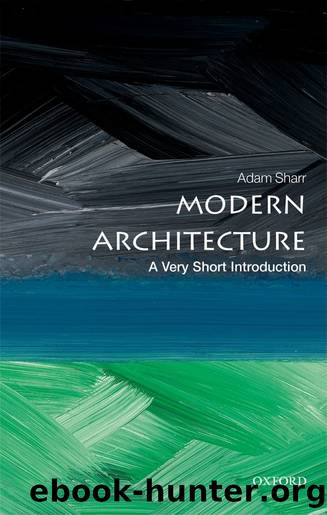Modern Architecture by Adam Sharr

Author:Adam Sharr [Sharr, Adam]
Language: eng
Format: epub
ISBN: 9780191086199
Publisher: OUP Oxford
Published: 2018-09-21T00:00:00+00:00
The chapel was engineered to achieve the forms Corbusier wanted, rather than following the logic of its materials. Its seemingly weighty roof was actually constructed like an aeroplane wing from slender struts. The walls were not solid concrete, as they first appear, but instead concrete frame infilled with rubble from the previous chapel, or reinforcement mesh onto which cement was sprayed, all covered over with white render.
The chapel pursued Corbusier’s enigmatic ideas about order and balance. Charles Jencks likened its shape to ‘a nun’s cowl, a monk’s hood, a ship’s prow, praying hands … [all] suggested … and denied at the same time’. Its towers have been imagined as standing stones, Neolithic funerary monuments, and vessels. Its forms have been read in the erotic terms of the naked body, as bellies, buttocks and breasts, and its sprayed concrete as human skin. The multiple meanings of its shapes echo Corbusier’s paintings, made concrete in search of poetic potential for postwar modern architecture. To his champions, the chapel represented a profoundly evocative rumination on human spirituality, its strange forms articulating enigmatically the ineffable mysteries of existence.
As with other kinds of intertextuality in film and literature, the more you know—in this instance about art, architecture, theology, and philosophy—the more the chapel gives back. This is not to say that ‘clever’ readings are right and ‘unknowing’ readings are wrong. Rather, it works on the levels of both raw experience and academic sophistication, done with sufficient ambiguity to keep offering fresh interpretations.
Like the Unité, the chapel again broke the tentative conventions of modern architecture. British architect James Stirling suggested that it prompted a ‘crisis of rationalism’, its striking ‘plastic’ forms requiring committed modernists to revisit the principles of their work. Ronchamp and the Unité took concrete from a straightforward expression of modernity—replacing loadbearing walls with frames and planes—to something altogether more complex, simultaneously modern and prehistoric. Both buildings spawned imitations, from close copies to comparable intertextual exercises.
Corbusier built five more Unités in France and Germany, but it was the Marseille block that became the model for swathes of Cold War housing in both the free-market West and communist East. Despite being widely copied, it was rarely understood well by its imitators. Raw concrete, which fared adequately in Marseille’s hot dry climate, survived less well in climates with damaging cycles of freeze and thaw. The Unité’s community facilities—shops, recreation roofscape, concierge, and lift attendants—rarely figured in the copies, producing housing silos that were often isolating, failing to mitigate anti-social behaviour. The Unité model thus became condemned as a failure.
In postwar decades, béton brut, and the intertextual form-making associated with it, symbolized a decisive rejection of the terror wrought by fascism. It described a new beginning—imagined partly in relation to ancient beginnings—which aspired to recombine community, technology, and architecture with a renewed sense of purpose. Today, however, that aspiration has been largely forgotten. Béton brut got tainted by the reputation of failed high-rise housing. And that failure continues to colour how people think about concrete architecture, and—indeed—modern architecture altogether.
Download
This site does not store any files on its server. We only index and link to content provided by other sites. Please contact the content providers to delete copyright contents if any and email us, we'll remove relevant links or contents immediately.
| Landmarks & Monuments | Religious Buildings |
| Residential |
Kathy Andrews Collection by Kathy Andrews(11272)
The remains of the day by Kazuo Ishiguro(8338)
Paper Towns by Green John(4751)
Spare by Prince Harry The Duke of Sussex(4746)
The Body: A Guide for Occupants by Bill Bryson(4534)
Industrial Automation from Scratch: A hands-on guide to using sensors, actuators, PLCs, HMIs, and SCADA to automate industrial processes by Olushola Akande(4419)
Be in a Treehouse by Pete Nelson(3621)
Harry Potter and the Goblet Of Fire by J.K. Rowling(3576)
Never by Ken Follett(3488)
Machine Learning at Scale with H2O by Gregory Keys | David Whiting(3427)
Goodbye Paradise(3412)
The Remains of the Day by Kazuo Ishiguro(3100)
Into Thin Air by Jon Krakauer(3099)
The Cellar by Natasha Preston(3058)
The Genius of Japanese Carpentry by Azby Brown(3009)
Drawing Shortcuts: Developing Quick Drawing Skills Using Today's Technology by Leggitt Jim(2910)
120 Days of Sodom by Marquis de Sade(2905)
Fairy Tale by Stephen King(2852)
The Man Who Died Twice by Richard Osman(2776)
